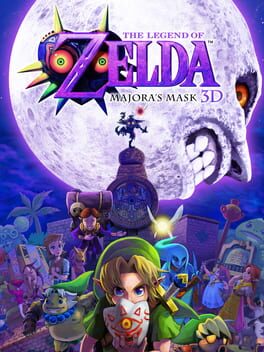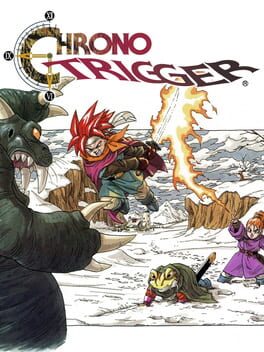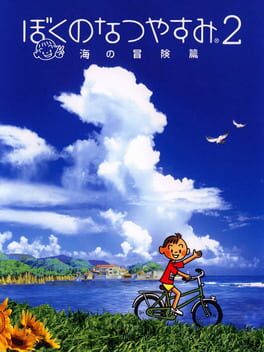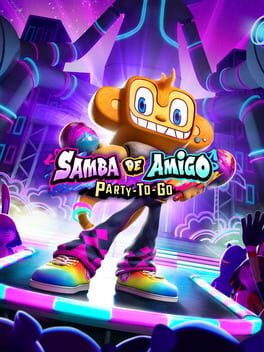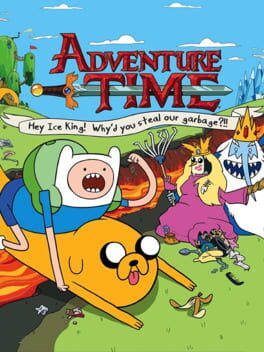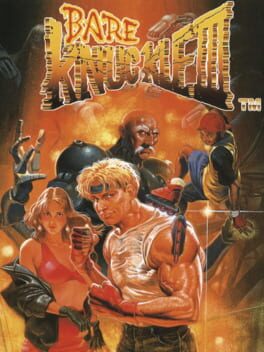icazinho
Bio
Brazilian visual artist. Retro and handheld gaming aficionado.
I enjoy rating stuff and making lists (such as “my top 10 favourites”, etc), so feel free to check them out if you ended up here in my profile and may like to know more about my impressions on the games I’ve played!
I usually like playing weird, unique games that try to break the mold of the medium, but at most times I'm just the usual old school platformer guy. Besides that, I absolutely love Metroidvanias, JRPGs, Adventure games and, sometimes, a little bit of Visual Novels, when they're not too cringe-inducing.
I don't usually play >bad< games that often (even though they amuse me), so my ratings tend to fluctuate towards higher scores. Well, they tend to follow this structure:
5.0★ = Flawless
4.5★ = Excellent
4.0★ = Great
3.5★ = Good
3.0★ = Good enough
2.5★ = Fine, I guess
2.0★ = "Meh"
1.5★ = Bad
1.0★ = Awful
0.5★ = Despisable
Brazilian visual artist. Retro and handheld gaming aficionado.
I enjoy rating stuff and making lists (such as “my top 10 favourites”, etc), so feel free to check them out if you ended up here in my profile and may like to know more about my impressions on the games I’ve played!
I usually like playing weird, unique games that try to break the mold of the medium, but at most times I'm just the usual old school platformer guy. Besides that, I absolutely love Metroidvanias, JRPGs, Adventure games and, sometimes, a little bit of Visual Novels, when they're not too cringe-inducing.
I don't usually play >bad< games that often (even though they amuse me), so my ratings tend to fluctuate towards higher scores. Well, they tend to follow this structure:
5.0★ = Flawless
4.5★ = Excellent
4.0★ = Great
3.5★ = Good
3.0★ = Good enough
2.5★ = Fine, I guess
2.0★ = "Meh"
1.5★ = Bad
1.0★ = Awful
0.5★ = Despisable
Badges

Loved
Gained 100+ total review likes

Gone Gold
Received 5+ likes on a review while featured on the front page

GOTY '22
Participated in the 2022 Game of the Year Event

Organized
Created a list folder with 5+ lists

Popular
Gained 15+ followers

Listed
Created 10+ public lists

Donor
Liked 50+ reviews / lists

Best Friends
Become mutual friends with at least 3 others

Busy Day
Journaled 5+ games in a single day

3 Years of Service
Being part of the Backloggd community for 3 years

GOTY '21
Participated in the 2021 Game of the Year Event

Liked
Gained 10+ total review likes

Noticed
Gained 3+ followers

GOTY '20
Participated in the 2020 Game of the Year Event

Gamer
Played 250+ games

N00b
Played 100+ games
Favorite Games
493
Total Games Played
000
Played in 2024
801
Games Backloggd
Recently Played See More
Recently Reviewed See More
I love writing reviews for the games I finish playing. I try to write them as much as I can, especially for games that I end up enamoured with, not only to actively train my English (not my first language) and writing skills as a whole, but to reflect upon and solidify my undying love for this medium, which, despite my current line of work and research, has remained as my most important and magical hobby ever since I was a kid, discovering Pokémon on my Game Boy.
When writing my reviews, I usually aim at tangible and mostly objective aspects of a particular game that makes it good or not, because I think that’s what matters the most for people reading a review at the end of the day; however, I simply cannot leave my personal, emotional impressions out of the picture since, following the parameters of autoethnograpgy, which are what guide the methodology behind the work I develop within the walls of academy, these particular accounts work as an extremely valuable source of data to wholly communicate the situation that’s being discussed on. As such, when I find myself with the urge to review a book, a film, or a video game, I aim to balance the more widely palpable aspects of that work with my own personal experience, since that also, and undeniably, constitutes what I’m trying to convey through my words.
I also try as much as I can to not spoil anything or to express myself in a way that may guide the reader’s view towards the game in a specific way, so that’s another way in which I believe giving personal accounts (and recognising them as such, rather than flavouring them as undeniable truths) makes an effective strategy to discuss upon something.
In the case of Boku no Natsuyasumi 2, however, I may end up giving a little bit more of personal insights to this review rather than talking about how its formal and mechanical aspects contribute to build such a meaningful, unforgettable experience, since it sucked me in so deeply into its tiny, mundane and magical world that I simply can’t fully express what playing this game meant to me in a way other than spreading out my own emotions upon the table. So, well, that’s a disclaimer to one of my longest and possibly the most difficult review I’ve written here.
I first got to know Kaz Ayabe and Millennium Kitchen’s work through Attack of the Friday Monsters! A Tokyo Tale, which I was fortunate enough to grab at my late teens, years before the closure of the 3DS’ eShop in March 2023.
It was July 2017. I was 19 and going on a family trip to the countryside for my summer vacation. When I wasn’t at the beach, enjoying nature and interacting with my relatives, you could find me, 3DS in hands, playing that game. I instantly fell in love with its gameplay, storytelling and setting, and it left a huge mark on me, especially by how perfect that moment was for it to fall onto my lap. A year prior, I was facing a crippling depression case, and after going through therapy I could finally find myself living life to its fullest, enjoying small aspects of my everyday life, and even going through a bittersweet (but fun) summer love story. It all fell into place… BUT, the game was too short. Sadly, sadly, too short.
It was a part of Level-5’s ”Guild” series, a series of bite-sized games co-developed alongside various directors (such as Goichi Suda and Keiji Inafune) for the Nintendo 3DS, being released in the west exclusively via the eShop. Attack of the Friday Monsters was, at that time, the only Kaz Ayabe game officially translated into English, and it has mostly everything a BokuNatsu game has – except for its length. Yeah, the game is well-paced enough, and will stay for very long on your memory, but its story occurs in only a single day of the main character’s life. Needless to say, it left me craving for much, much more of that unique style of gameplay, and that’s how I ended up discovering Boku no Natsuyasumi – only to be immediately hit by the language barrier truck.
Since then, I have spent the following years with a bitter taste in my mouth, falling ill to the lingering urge to play Boku no Natsuyasumi haunting me every summer, always reminding me of that one summer in which I played Attack of the Friday Monsters. I’ve flirted many times with the idea of playing the first game with a guide by my side, but always gave up on it by thinking about how much that would end up hindering my own personal experience, since these games rely on their narratives, and I simply couldn’t find myself willing to discard a possible, remote way of playing them in a language I can read over playing them in such an suboptimal manner. And that’s when it happened – a fan translation effort was announced in 2021, and I was beyond overjoyed by this news.
Well, we are still waiting for the first game to be translated (respectfully sobbing here lol). But, as we were doing so, Hilltop, one of my favourite guys in the fan translation romhacking scene, gifted us earlier this year by announcing he was working on the second game, released in 2002 for the PS2. This translation was publicly released on November 1, 2023, and now we finally have means to play a game from this extremely special series fully in English.
After Attack of the Friday Monsters, we ended up getting the latest Shin-chan game localised in English and other languages as well, which is a bliss. Sadly, I played the beginning of it, and it didn’t make much to me. Gameplaywise, it’s definitely a BokuNatsu game, but stripped from its more grounded, believable setting in favour of a more fantastical, whimsical one; at the same time, it’s still a family-friendly cozy Japanese countryside story, which takes out a bit of Shin-chan’s depraved and acid character. At the end of the day, it’s still a beautiful and fun game, and it’s always great to have one of Millennium Kitchen’s games localised in the west, but I still have to give this one another chance, in another time.
Well, that’s when Boku no Natsuyasumi 2 comes in – and, gladly, these games’ stories are not connected and their gameplay is pretty much the same across the board, so we don’t lose anything by playing the second one while we wait for the first one to be translated. :)
As it was with Attack of the Friday Monsters, this game comes upon me in a huge moment in my life. Sadly, a bad one. Adult life sucks. For the past two weeks, especially, it’s become borderline unbearable at many moments. I’m once again going through therapy, after showing signs of having developed a panic disorder. Dealing with finishing up my master’s degree paper, coupled with relationship and economic issues with my partner have been beyond exhausting. It’s been particularly challenging since my partner is going through a series of severe mental health crisis – she’s diagnosed with BPD, and going through similar issues as me regarding work and facing adulthood in this broken, capitalist mess of a world we live in, and for this past week she had to travel alone whilst undergoing severe psychiatric episodes. Me, being away from her, and having to juggle between my concerns about her mental state and dealing with arranging flight delays for her to heal before stepping into a plane again, constantly staying on the phone with our families to share news on her, racing against my paper’s deadline… It’s all been damaging me physically, mentally, emotionally and even spiritually.
It was because all of that, despite all the work I have yet to do, that I decided to add BokuNatsu2 into my days. I did it for my own good – I just needed to breathe, I needed to feed on some lightness to escape a bit from the gargantuan pressure that my current life is being subjected to.
It was exactly what I needed. For better and for worse.
“Boku” [ぼく] is one of the many ways to say “I” or “Me” in Japanese, and it’s generally used by young and teenager boys. The title of the game, “Boku no Natsuyasumi” [ぼくのなつやすみ], means “My Summer Vacation”. In a fun way to direct the player’s experience, though, “Boku” is also the name of the character you play as, so as much as you can imprint your own experiences onto him, you’re also wearing his shoes and seeing the world as him – the child you can no longer go back to be.
Boku, at 9 years-old, is on the brink of becoming a big brother. In order to properly prepare for the arrival of a new member in the family, Boku’s parents decide to send him to expend his August 1975 summer vacation on the seaside town of Fumi, where his uncle and aunt live and run a guest house alongside their two boys, Takeshi and Shigeru. In this very small countryside town, Boku gets to know each one that lives there and what things they are going through, whilst also being able to collect bugs and having them fight against the ones your cousins have, fish, ride on a bicycle, walk through forests and mountains and swim on the beach, all of that to your child heart’s content. Time passes as you go through each area of the game, which are all beautifully and masterfully hand-painted, and your ultimate objective is to live each day to the fullest, enjoying your 20th century holiday in a time when things were only starting to change, but still went on a much simpler and slower pace.
I don’t think I’m fully able to collect here and put into words every emotion I felt whilst playing BokuNatsu2, even if I’m trying to do so. I got attached to every single person I got to know in that small town, deeply caring for each one of them, and grasping things that Boku, in his innocent interpretations of life, could only left for us, adults, to fully understand. Through the simplest of dialogues, I got hit and overflown by bliss, curiosity and sadness, especially by the end of my time in Fumi, when both me and Boku, as excited as he was to meet his baby brother, didn’t want that summer to end.
You can do as you please as you decide how to spend your time in Fumi – but, if I may, I’d recommend you not to stick too much to guides, and go with the flow of things, discovering things by your own. Believe me, by the moment you step foot into a guide, as helpful as it may be, it takes away a bit of the fun and sense of discovery inherent to BokuNatsu, as much as it would if I prolonged myself talking about its mechanics and specific moments. Instead, I’d rather share a collection of some things I found out by myself and by reading a guide, and which I think can be helpful for new players to enjoy this game as much as possible:
• Yeah, tank controls. Deal with them, they’re way simpler and intuitive here than it would be in, say, a PS1 survival horror game. Press X to walk, left and right on the d-pad to turn, down to turn back of face ahead of you, and O to interact with things and people.
• Press R1 to equip/unequip the bug net without having to open the pause menu every time.
• Talk to Hikari everyday and ask her for her origami fortune-telling. This is a spoiler-free way to know what to do each day, when and who to talk with.
• If you stay awake past 11 p.m., you won’t be able to wake up in time for the morning calisthenics – a small, cute cutscene that plays at the beginning of each day, which daily marks a stamp on an attendance card you have. Not missing these may lead to something special… but I wouldn’t know, since I only figured this thing out by August 10th! :P
• When talking to someone, talk to them again as soon as they finish speaking. Talking to someone twice is the only way to hear everything a character has to say.
• People have their own everyday schedules, doing slightly different things every so often. These are also dictated by the hours of the day. Pay close attention to their behaviours, since that’s how you’ll be able to talk to everyone, increasingly getting to know their passions, fears, stories and personalities.
• The game shows you the passage of time in more ways than just one, and very cleverly through the sounds of the insects in the wilderness surrounding Fumi. In the early morning you can mostly hear birds chirping, but after 10 a.m. the cicadas start to frolic. By noon and after it, you can hear different and louder cicada cries, and close to 5 p.m., the evening Higurashi cicadas start to sing their melancholic symphony, which remains imperious throughout the sunset. Pay attention to these as you’re planning where to go within the time that you’re given.
• That’s not the only way to check time, tough! Check the table at the guest house living room, right next to your bedroom, to find a small clock that you can borrow, and it will remain in the pause menu for the rest of the game!
• Beehives function as warp points: they are generally located on distant places, so if you want to be in somewhere else in town, interact with one of these and Boku will faint from the bee stings, sending you all the way back to the guest house without sacrificing time!
• The bicycle is near the guest house’s front entrance, close to where the car is, but it’s easy to not notice it since its silhouette has been dimmed out. Once you see it, though, there’s no way to unsee it. It’s fun to ride it and it can get you places faster than walking.
• Take care of the flowers every day!
• Give Grandpa Sagara and your Aunt shoulder massages every day. Doing so will grant you 20 Yen per day, which you can use to buy different snacks, a battle ship model to play with and Jet Ciders to get more bottle caps.
• Swim. Not only it’s one of the most fun parts of the game, and not only its lovely to explore an early-PS2 ocean floor, but its there where you can find most of the game’s collectible Jet Cider dinosaur bottle caps, which increase your stamina underwater. There are some very special secrets to be found in the ocean!
• Bug fights are also fun! I’d recommend you to turn your attention to Miyama stags and Rhino beetles as son as they are available, and train two or three as much as you can. When the time to face the last King-rank foe comes, keep your bug cage full of bugs that have a good balance of strength and stamina. Remember this! You’ll absolutely need a lot of bugs for this last fight!
• There’s simply no way to see every single thing in this game in a single playthrough. Don’t worry about missing a thing or two, really: it only adds up to its beautiful replay factor.
• Don’t rush. If you can, and as much as you can, try to play tiny bits of it every day, and it will leave an even bigger impact on you at the end. I sadly had to rush a bit because of my own responsibilities that needed to be taken care of, but I beg you to enjoy this one in tiny scoops.
The rest of it, I won’t spoil any further. This is supposed to be your summer vacation, not mine.
What I can say, though, is what Yasuko points out herself during a dialogue: it feels like the second half of summer is shorter than the first, and I definitely felt it. Personally, I think that’s the only aspect that’s in detriment of the whole experience, and the reason why I’m giving this game a 4.5 star rating instead of a 5 star one: the first half of the game was where I had more fun with; where things happened at a more exciting pace. In the second half, I found myself doing mostly repetitive stuff, not discovering anything particularly new, and just wandering around Fumi to extend my time on it. Don’t get me wrong: the game doesn’t cease to amaze the player with its masterfully crafted simplicity, and it wraps everything up beautifully by the last few days of August; I just wish the quirks of the in-game events were a liiiiittle bit more evenly balanced throughout the entire game’s lenght.
Despite this weak point, though, Boku no Natsuyasumi 2 is a masterpiece.
As pointed out by other users here, this game has the ability to send you back to a simpler time of your life, and remind you of how great it was to experience the world through the lens of a child. At times, the adult Boku’s calm voice comes in as a narrator, telling us, for example, how he felt the sunlight coming through and energising his entire body as he stretched the palm of his hand towards the sun, checking how see-through his flesh looked. Moments as these are the ones I treasured the most, since its exactly through these mundane and simple moments that the game conveys it’s most profound insights into everyday life, our struggles and our own important memories of our respective pasts.
With all the sh#t going on in my life, I can’t really put into words how important it was to me to allow myself to play tiny bits of this game throughout this last week. It reminded me of simple things, the things I treasure and miss the most in myself and in others. It reminded me of happy moments, of my summer countryside holidays with my cousins as we grew up together, of spending entire days watching cartoons and playing by myself in the backyard, of playing soccer with my grandpa, and hearing all sorts of stories from my late grandma, which recently left us, but had been away for a while by the hands of Alzheimer. It reminded me, as Yoshika tells you by the end of the game, that there is, indeed, true happiness, and we should strive to find it wherever it may be in the world.
On the other hand, by the end of it all, I felt utterly devastated. I simply wasn’t ready to say goodbye to Fumi and the summer of 1975. Having to face adulthood again is unbearably tough, and even before finishing the game, I found myself crying in bed a few times by thinking about it and my long-gone childhood – undeniably, the best and happiest time of my life.
As the end credits rolled, it happened – two years after playing Journey, Boku no Natsuyasumi took its crown as the game that made me cry the most. I kid you not: it completely liquified me. It was painful to wait to play this game in English, but having to part with it was extremely more.
I cannot recommend this game enough. It may not appeal to everyone, but it’s games like these that keep reminding me how special, meaningful and powerful video games can be, and its by reviews like this one that I try to share a bit of how much I love them; how much I feel this medium should be valorised and brought upon higher grounds, away from your typical video games that, as important as they might be to the industry and to us players, undeniably paint a limited picture of what games can do and are supposed to be.
As the end of summer draws near (at least here in northern Brazil), My Summer Vacation in Fumi is over. All that is left to me is cherish my time spent on it, magically living under a gentle, adventurously curious and caring 9-year-old boy’s skin, in a place far away from where I am, in a time long before I was even born. Being able to live lives such as these, turning something apart from my reality a part of it, is what makes video games so special and important to me, and as much as I’m eager for the first game to be finally translated, now, I can only think about my time in Boku no Natsuyasumi 2, and be glad that I had the chance to taste it in this lifetime of mine.
When writing my reviews, I usually aim at tangible and mostly objective aspects of a particular game that makes it good or not, because I think that’s what matters the most for people reading a review at the end of the day; however, I simply cannot leave my personal, emotional impressions out of the picture since, following the parameters of autoethnograpgy, which are what guide the methodology behind the work I develop within the walls of academy, these particular accounts work as an extremely valuable source of data to wholly communicate the situation that’s being discussed on. As such, when I find myself with the urge to review a book, a film, or a video game, I aim to balance the more widely palpable aspects of that work with my own personal experience, since that also, and undeniably, constitutes what I’m trying to convey through my words.
I also try as much as I can to not spoil anything or to express myself in a way that may guide the reader’s view towards the game in a specific way, so that’s another way in which I believe giving personal accounts (and recognising them as such, rather than flavouring them as undeniable truths) makes an effective strategy to discuss upon something.
In the case of Boku no Natsuyasumi 2, however, I may end up giving a little bit more of personal insights to this review rather than talking about how its formal and mechanical aspects contribute to build such a meaningful, unforgettable experience, since it sucked me in so deeply into its tiny, mundane and magical world that I simply can’t fully express what playing this game meant to me in a way other than spreading out my own emotions upon the table. So, well, that’s a disclaimer to one of my longest and possibly the most difficult review I’ve written here.
I first got to know Kaz Ayabe and Millennium Kitchen’s work through Attack of the Friday Monsters! A Tokyo Tale, which I was fortunate enough to grab at my late teens, years before the closure of the 3DS’ eShop in March 2023.
It was July 2017. I was 19 and going on a family trip to the countryside for my summer vacation. When I wasn’t at the beach, enjoying nature and interacting with my relatives, you could find me, 3DS in hands, playing that game. I instantly fell in love with its gameplay, storytelling and setting, and it left a huge mark on me, especially by how perfect that moment was for it to fall onto my lap. A year prior, I was facing a crippling depression case, and after going through therapy I could finally find myself living life to its fullest, enjoying small aspects of my everyday life, and even going through a bittersweet (but fun) summer love story. It all fell into place… BUT, the game was too short. Sadly, sadly, too short.
It was a part of Level-5’s ”Guild” series, a series of bite-sized games co-developed alongside various directors (such as Goichi Suda and Keiji Inafune) for the Nintendo 3DS, being released in the west exclusively via the eShop. Attack of the Friday Monsters was, at that time, the only Kaz Ayabe game officially translated into English, and it has mostly everything a BokuNatsu game has – except for its length. Yeah, the game is well-paced enough, and will stay for very long on your memory, but its story occurs in only a single day of the main character’s life. Needless to say, it left me craving for much, much more of that unique style of gameplay, and that’s how I ended up discovering Boku no Natsuyasumi – only to be immediately hit by the language barrier truck.
Since then, I have spent the following years with a bitter taste in my mouth, falling ill to the lingering urge to play Boku no Natsuyasumi haunting me every summer, always reminding me of that one summer in which I played Attack of the Friday Monsters. I’ve flirted many times with the idea of playing the first game with a guide by my side, but always gave up on it by thinking about how much that would end up hindering my own personal experience, since these games rely on their narratives, and I simply couldn’t find myself willing to discard a possible, remote way of playing them in a language I can read over playing them in such an suboptimal manner. And that’s when it happened – a fan translation effort was announced in 2021, and I was beyond overjoyed by this news.
Well, we are still waiting for the first game to be translated (respectfully sobbing here lol). But, as we were doing so, Hilltop, one of my favourite guys in the fan translation romhacking scene, gifted us earlier this year by announcing he was working on the second game, released in 2002 for the PS2. This translation was publicly released on November 1, 2023, and now we finally have means to play a game from this extremely special series fully in English.
After Attack of the Friday Monsters, we ended up getting the latest Shin-chan game localised in English and other languages as well, which is a bliss. Sadly, I played the beginning of it, and it didn’t make much to me. Gameplaywise, it’s definitely a BokuNatsu game, but stripped from its more grounded, believable setting in favour of a more fantastical, whimsical one; at the same time, it’s still a family-friendly cozy Japanese countryside story, which takes out a bit of Shin-chan’s depraved and acid character. At the end of the day, it’s still a beautiful and fun game, and it’s always great to have one of Millennium Kitchen’s games localised in the west, but I still have to give this one another chance, in another time.
Well, that’s when Boku no Natsuyasumi 2 comes in – and, gladly, these games’ stories are not connected and their gameplay is pretty much the same across the board, so we don’t lose anything by playing the second one while we wait for the first one to be translated. :)
As it was with Attack of the Friday Monsters, this game comes upon me in a huge moment in my life. Sadly, a bad one. Adult life sucks. For the past two weeks, especially, it’s become borderline unbearable at many moments. I’m once again going through therapy, after showing signs of having developed a panic disorder. Dealing with finishing up my master’s degree paper, coupled with relationship and economic issues with my partner have been beyond exhausting. It’s been particularly challenging since my partner is going through a series of severe mental health crisis – she’s diagnosed with BPD, and going through similar issues as me regarding work and facing adulthood in this broken, capitalist mess of a world we live in, and for this past week she had to travel alone whilst undergoing severe psychiatric episodes. Me, being away from her, and having to juggle between my concerns about her mental state and dealing with arranging flight delays for her to heal before stepping into a plane again, constantly staying on the phone with our families to share news on her, racing against my paper’s deadline… It’s all been damaging me physically, mentally, emotionally and even spiritually.
It was because all of that, despite all the work I have yet to do, that I decided to add BokuNatsu2 into my days. I did it for my own good – I just needed to breathe, I needed to feed on some lightness to escape a bit from the gargantuan pressure that my current life is being subjected to.
It was exactly what I needed. For better and for worse.
“Boku” [ぼく] is one of the many ways to say “I” or “Me” in Japanese, and it’s generally used by young and teenager boys. The title of the game, “Boku no Natsuyasumi” [ぼくのなつやすみ], means “My Summer Vacation”. In a fun way to direct the player’s experience, though, “Boku” is also the name of the character you play as, so as much as you can imprint your own experiences onto him, you’re also wearing his shoes and seeing the world as him – the child you can no longer go back to be.
Boku, at 9 years-old, is on the brink of becoming a big brother. In order to properly prepare for the arrival of a new member in the family, Boku’s parents decide to send him to expend his August 1975 summer vacation on the seaside town of Fumi, where his uncle and aunt live and run a guest house alongside their two boys, Takeshi and Shigeru. In this very small countryside town, Boku gets to know each one that lives there and what things they are going through, whilst also being able to collect bugs and having them fight against the ones your cousins have, fish, ride on a bicycle, walk through forests and mountains and swim on the beach, all of that to your child heart’s content. Time passes as you go through each area of the game, which are all beautifully and masterfully hand-painted, and your ultimate objective is to live each day to the fullest, enjoying your 20th century holiday in a time when things were only starting to change, but still went on a much simpler and slower pace.
I don’t think I’m fully able to collect here and put into words every emotion I felt whilst playing BokuNatsu2, even if I’m trying to do so. I got attached to every single person I got to know in that small town, deeply caring for each one of them, and grasping things that Boku, in his innocent interpretations of life, could only left for us, adults, to fully understand. Through the simplest of dialogues, I got hit and overflown by bliss, curiosity and sadness, especially by the end of my time in Fumi, when both me and Boku, as excited as he was to meet his baby brother, didn’t want that summer to end.
You can do as you please as you decide how to spend your time in Fumi – but, if I may, I’d recommend you not to stick too much to guides, and go with the flow of things, discovering things by your own. Believe me, by the moment you step foot into a guide, as helpful as it may be, it takes away a bit of the fun and sense of discovery inherent to BokuNatsu, as much as it would if I prolonged myself talking about its mechanics and specific moments. Instead, I’d rather share a collection of some things I found out by myself and by reading a guide, and which I think can be helpful for new players to enjoy this game as much as possible:
• Yeah, tank controls. Deal with them, they’re way simpler and intuitive here than it would be in, say, a PS1 survival horror game. Press X to walk, left and right on the d-pad to turn, down to turn back of face ahead of you, and O to interact with things and people.
• Press R1 to equip/unequip the bug net without having to open the pause menu every time.
• Talk to Hikari everyday and ask her for her origami fortune-telling. This is a spoiler-free way to know what to do each day, when and who to talk with.
• If you stay awake past 11 p.m., you won’t be able to wake up in time for the morning calisthenics – a small, cute cutscene that plays at the beginning of each day, which daily marks a stamp on an attendance card you have. Not missing these may lead to something special… but I wouldn’t know, since I only figured this thing out by August 10th! :P
• When talking to someone, talk to them again as soon as they finish speaking. Talking to someone twice is the only way to hear everything a character has to say.
• People have their own everyday schedules, doing slightly different things every so often. These are also dictated by the hours of the day. Pay close attention to their behaviours, since that’s how you’ll be able to talk to everyone, increasingly getting to know their passions, fears, stories and personalities.
• The game shows you the passage of time in more ways than just one, and very cleverly through the sounds of the insects in the wilderness surrounding Fumi. In the early morning you can mostly hear birds chirping, but after 10 a.m. the cicadas start to frolic. By noon and after it, you can hear different and louder cicada cries, and close to 5 p.m., the evening Higurashi cicadas start to sing their melancholic symphony, which remains imperious throughout the sunset. Pay attention to these as you’re planning where to go within the time that you’re given.
• That’s not the only way to check time, tough! Check the table at the guest house living room, right next to your bedroom, to find a small clock that you can borrow, and it will remain in the pause menu for the rest of the game!
• Beehives function as warp points: they are generally located on distant places, so if you want to be in somewhere else in town, interact with one of these and Boku will faint from the bee stings, sending you all the way back to the guest house without sacrificing time!
• The bicycle is near the guest house’s front entrance, close to where the car is, but it’s easy to not notice it since its silhouette has been dimmed out. Once you see it, though, there’s no way to unsee it. It’s fun to ride it and it can get you places faster than walking.
• Take care of the flowers every day!
• Give Grandpa Sagara and your Aunt shoulder massages every day. Doing so will grant you 20 Yen per day, which you can use to buy different snacks, a battle ship model to play with and Jet Ciders to get more bottle caps.
• Swim. Not only it’s one of the most fun parts of the game, and not only its lovely to explore an early-PS2 ocean floor, but its there where you can find most of the game’s collectible Jet Cider dinosaur bottle caps, which increase your stamina underwater. There are some very special secrets to be found in the ocean!
• Bug fights are also fun! I’d recommend you to turn your attention to Miyama stags and Rhino beetles as son as they are available, and train two or three as much as you can. When the time to face the last King-rank foe comes, keep your bug cage full of bugs that have a good balance of strength and stamina. Remember this! You’ll absolutely need a lot of bugs for this last fight!
• There’s simply no way to see every single thing in this game in a single playthrough. Don’t worry about missing a thing or two, really: it only adds up to its beautiful replay factor.
• Don’t rush. If you can, and as much as you can, try to play tiny bits of it every day, and it will leave an even bigger impact on you at the end. I sadly had to rush a bit because of my own responsibilities that needed to be taken care of, but I beg you to enjoy this one in tiny scoops.
The rest of it, I won’t spoil any further. This is supposed to be your summer vacation, not mine.
What I can say, though, is what Yasuko points out herself during a dialogue: it feels like the second half of summer is shorter than the first, and I definitely felt it. Personally, I think that’s the only aspect that’s in detriment of the whole experience, and the reason why I’m giving this game a 4.5 star rating instead of a 5 star one: the first half of the game was where I had more fun with; where things happened at a more exciting pace. In the second half, I found myself doing mostly repetitive stuff, not discovering anything particularly new, and just wandering around Fumi to extend my time on it. Don’t get me wrong: the game doesn’t cease to amaze the player with its masterfully crafted simplicity, and it wraps everything up beautifully by the last few days of August; I just wish the quirks of the in-game events were a liiiiittle bit more evenly balanced throughout the entire game’s lenght.
Despite this weak point, though, Boku no Natsuyasumi 2 is a masterpiece.
As pointed out by other users here, this game has the ability to send you back to a simpler time of your life, and remind you of how great it was to experience the world through the lens of a child. At times, the adult Boku’s calm voice comes in as a narrator, telling us, for example, how he felt the sunlight coming through and energising his entire body as he stretched the palm of his hand towards the sun, checking how see-through his flesh looked. Moments as these are the ones I treasured the most, since its exactly through these mundane and simple moments that the game conveys it’s most profound insights into everyday life, our struggles and our own important memories of our respective pasts.
With all the sh#t going on in my life, I can’t really put into words how important it was to me to allow myself to play tiny bits of this game throughout this last week. It reminded me of simple things, the things I treasure and miss the most in myself and in others. It reminded me of happy moments, of my summer countryside holidays with my cousins as we grew up together, of spending entire days watching cartoons and playing by myself in the backyard, of playing soccer with my grandpa, and hearing all sorts of stories from my late grandma, which recently left us, but had been away for a while by the hands of Alzheimer. It reminded me, as Yoshika tells you by the end of the game, that there is, indeed, true happiness, and we should strive to find it wherever it may be in the world.
On the other hand, by the end of it all, I felt utterly devastated. I simply wasn’t ready to say goodbye to Fumi and the summer of 1975. Having to face adulthood again is unbearably tough, and even before finishing the game, I found myself crying in bed a few times by thinking about it and my long-gone childhood – undeniably, the best and happiest time of my life.
As the end credits rolled, it happened – two years after playing Journey, Boku no Natsuyasumi took its crown as the game that made me cry the most. I kid you not: it completely liquified me. It was painful to wait to play this game in English, but having to part with it was extremely more.
I cannot recommend this game enough. It may not appeal to everyone, but it’s games like these that keep reminding me how special, meaningful and powerful video games can be, and its by reviews like this one that I try to share a bit of how much I love them; how much I feel this medium should be valorised and brought upon higher grounds, away from your typical video games that, as important as they might be to the industry and to us players, undeniably paint a limited picture of what games can do and are supposed to be.
As the end of summer draws near (at least here in northern Brazil), My Summer Vacation in Fumi is over. All that is left to me is cherish my time spent on it, magically living under a gentle, adventurously curious and caring 9-year-old boy’s skin, in a place far away from where I am, in a time long before I was even born. Being able to live lives such as these, turning something apart from my reality a part of it, is what makes video games so special and important to me, and as much as I’m eager for the first game to be finally translated, now, I can only think about my time in Boku no Natsuyasumi 2, and be glad that I had the chance to taste it in this lifetime of mine.
I remember when this game came out. It was the first proper Adventure Time video game, and I was in a HUGE anticipation for it to be released.
Back then I was in high school, and Adventure Time was a big thing to me and my friends. We even went to the point of vandalising the school with marker drawings of Gunter everywhere. Yeah, good times.
Well, I got it on my DS as soon as it released and, to my surprise… it took me only a single day to beat it.
OK, the game was fine, but the short length of the adventure left a sour taste in my mouth.
But, well, I found myself thinking about the game this afternoon, and decided to give it a try on my 3DS. Unsurprisingly, it took less than five hours for a 11-years-older me (damn, is it that long already?) to fully complete the game in a single sitting.
Alright, it’s a game made for kids, so you can kind of expect it to be easy. The music is fine, but super repetitive and with a flair of chiptune every now and then, with some very muffled voiced recordings. There’s a huge amount of backtracking going on as well, and it’s mostly the boring type of backtrack. Also, the game’s story, despite being fine for an Adventure Time episode, was nothing to write home about.
… however, yeah, it’s a charming and fun little game.
The plot and characters are reminiscent of the earlier seasons of the show, which were my favourites, and it is undoubtedly fun to travel through Ooo and chat with its denizens.
All of that in a Zelda II-inspired setting and gameplay. Of all the Zelda-like formulas they could have come up with, they went for that one; and they made it fun and interesting, with a progression that, easy as it is, doesn’t hold the player’s hand and makes it so that they match the puzzle pieces by themselves.
And, well, it’s WayForward we’re talking about here, so you can expect at least a tad bit of polish.
The game has super tight controls and some very nicely done pixel art visuals that look great even on a 3DS XL screen.
Also, the game looks better on the 3DS than on the DS, with additional details on the foregrounds and the backgrounds.
All in all, despite being far from a blockbuster, it was a great first game for the franchise. They executed some nice and fun ideas very well, and condensed all of it in a bite-sized adventure that, despite being super easy, was fun enough at the end.
I ended up enjoying it as much as I originally did eleven years ago. But, there really isn’t any reason for me to replay it in the future.
Except for nostalgia reasons, maybe. Waiting for this game to be released back then was part of the experience itself, and I’d still love to get the collector’s edition that came with a stylus shaped as Finn’s sword.
Back then I was in high school, and Adventure Time was a big thing to me and my friends. We even went to the point of vandalising the school with marker drawings of Gunter everywhere. Yeah, good times.
Well, I got it on my DS as soon as it released and, to my surprise… it took me only a single day to beat it.
OK, the game was fine, but the short length of the adventure left a sour taste in my mouth.
But, well, I found myself thinking about the game this afternoon, and decided to give it a try on my 3DS. Unsurprisingly, it took less than five hours for a 11-years-older me (damn, is it that long already?) to fully complete the game in a single sitting.
Alright, it’s a game made for kids, so you can kind of expect it to be easy. The music is fine, but super repetitive and with a flair of chiptune every now and then, with some very muffled voiced recordings. There’s a huge amount of backtracking going on as well, and it’s mostly the boring type of backtrack. Also, the game’s story, despite being fine for an Adventure Time episode, was nothing to write home about.
… however, yeah, it’s a charming and fun little game.
The plot and characters are reminiscent of the earlier seasons of the show, which were my favourites, and it is undoubtedly fun to travel through Ooo and chat with its denizens.
All of that in a Zelda II-inspired setting and gameplay. Of all the Zelda-like formulas they could have come up with, they went for that one; and they made it fun and interesting, with a progression that, easy as it is, doesn’t hold the player’s hand and makes it so that they match the puzzle pieces by themselves.
And, well, it’s WayForward we’re talking about here, so you can expect at least a tad bit of polish.
The game has super tight controls and some very nicely done pixel art visuals that look great even on a 3DS XL screen.
Also, the game looks better on the 3DS than on the DS, with additional details on the foregrounds and the backgrounds.
All in all, despite being far from a blockbuster, it was a great first game for the franchise. They executed some nice and fun ideas very well, and condensed all of it in a bite-sized adventure that, despite being super easy, was fun enough at the end.
I ended up enjoying it as much as I originally did eleven years ago. But, there really isn’t any reason for me to replay it in the future.
Except for nostalgia reasons, maybe. Waiting for this game to be released back then was part of the experience itself, and I’d still love to get the collector’s edition that came with a stylus shaped as Finn’s sword.

